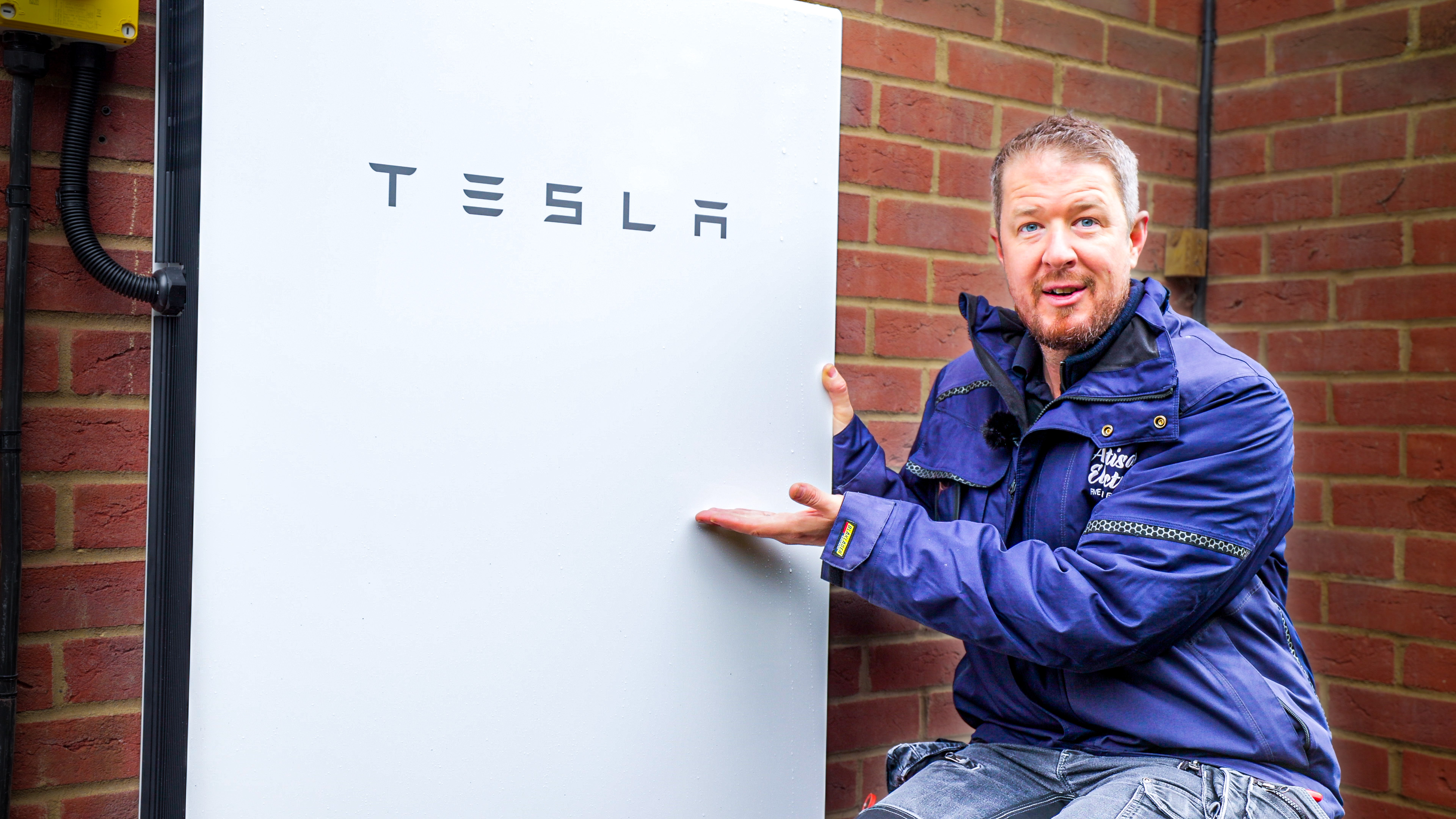
Do you have solar and want to store excess power to use overnight? You want backup power in the event of a grid outage? Do you want a battery system to leverage cheap overnight tariffs to reduce your energy costs?
Then here are 10 things you MUST KNOW before you get a home battery storage system installed.
1. What are the benefits of battery storage?
Improve the use of your renewable energy – by incorporating a home battery storage system, you unlock the capability to capture renewable energy, preserving it for utilisation during periods of low energy production. This product empowers you to use more of your own solar energy.
Backup power – If your area has a lot of power outages then a battery storage system that provides whole house backup is a good option. You won’t get cut off from the world in case there is a power outage as you will have the battery system to be able to run your home for some time. This gives you energy security and peace of mind.
Long-term cost savings – whilst they may not be cheap to install, they often pay for themselves over time. You can make huge savings to your electricity bills whilst adding more value to your home. You can even earn money from a battery system by gathering unused energy and giving it back to the grid at peak times.
Another more obvious benefit is helping to reduce your carbon footprint and harnessing renewable energy will help reduce your household greenhouse gas emissions and help minimise your impact on our planet.
Get a quote here – https://app.openquote.net/company/artisanelectrics
2. What brand should you choose?
The three main brands that we are installing right now for customers are the MyEnergi Libbi, Tesla Powerwall 2, and the Givenergy All In One battery systems. These 3 systems are all great in their own ways but it may be a struggle to know which one you would like installed.
MyEnergi Libbi – Part of the MyEnergi Ecosystem – this battery storage system works with Zappi and Eddi to enable you to use even more of your solar energy. It has a capacity of 5/10/15/20kWh (comes in 5kWh modules) and there are two inverter options – 3.68 or 5kW.
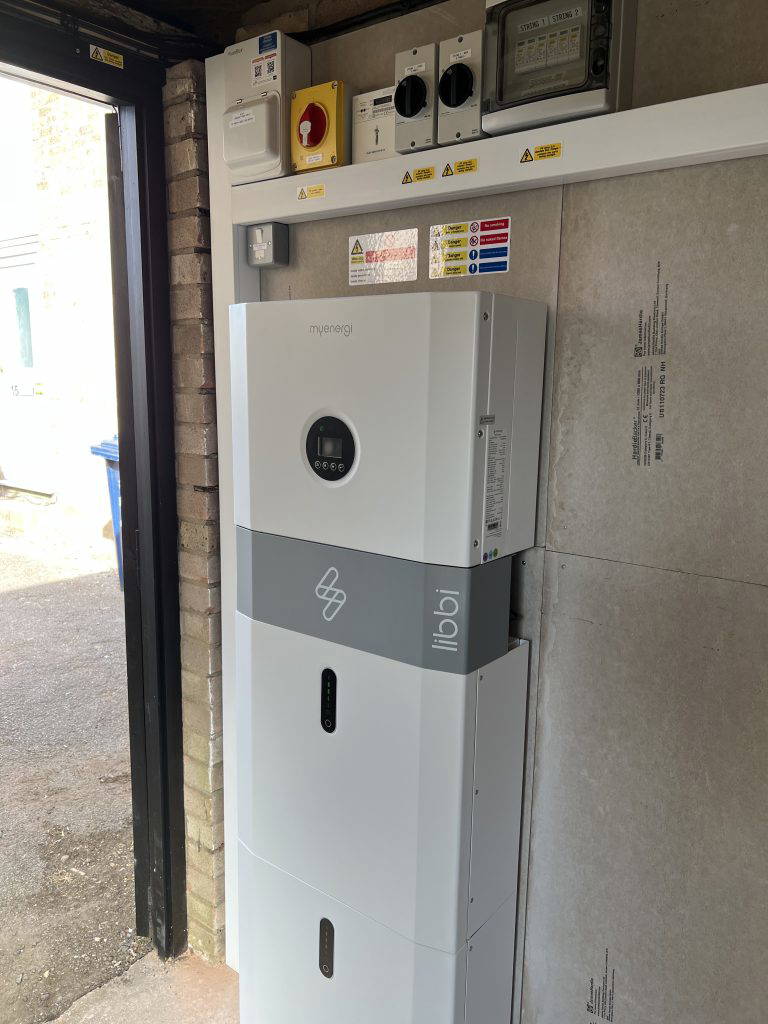 Tesla Powerwall 2 – The Tesla Powerwall 2 has an energy capacity of 13.5kWh but can be stacked up to 4 times with multiple powerwalls, it has a max charge/discharge rate of 5kW, or 7kW peak for 30 seconds.
Tesla Powerwall 2 – The Tesla Powerwall 2 has an energy capacity of 13.5kWh but can be stacked up to 4 times with multiple powerwalls, it has a max charge/discharge rate of 5kW, or 7kW peak for 30 seconds. 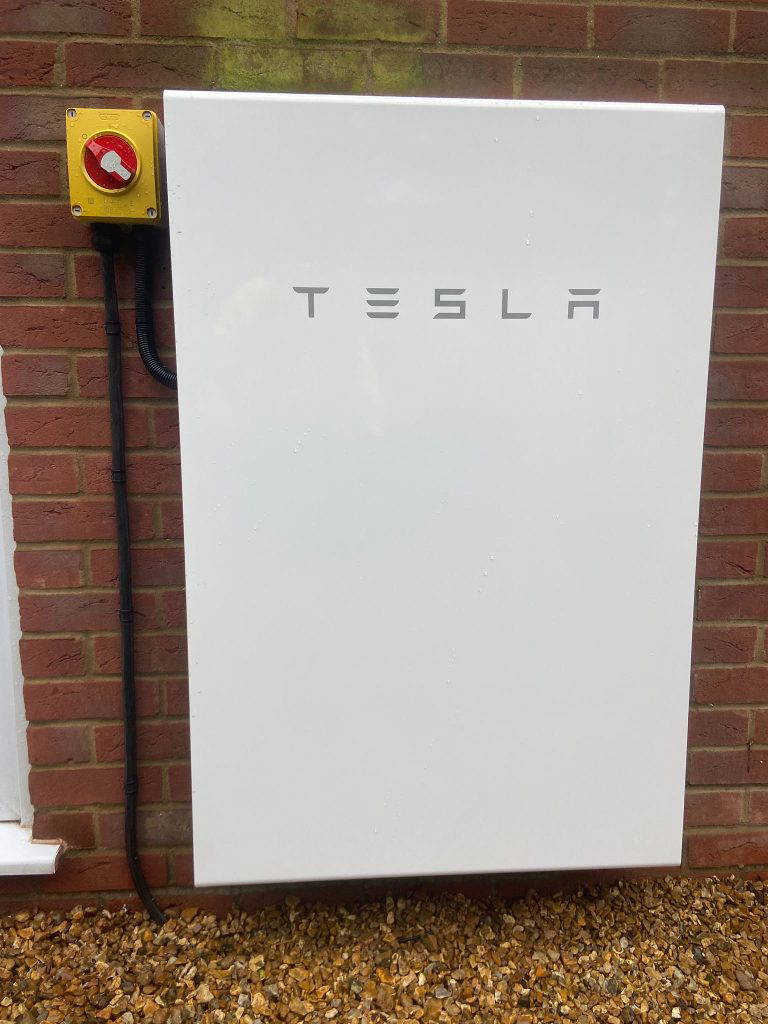
Givenergy All-in-one – The GivEnergy All-in-one system has an energy capacity of 13.5kWh and comes in 3.68/5/6kW charge/discharge ratings. 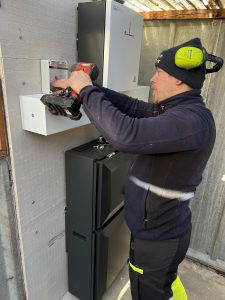
The Powerwall 2 and GivEnergy are all-in-one systems, with the charger and battery combined into one system. The MyEnergi system has a separate charger and battery, making them less compact and aesthetically pleasing, but more ‘modular’ with greater design flexibility.
The Tesla Powerwall 2 and GivEnergy All In One provide whole-house back-up which means your house will be able to run if there is an event of a power cut.
The GivEnergy and the Tesla Powerwall 2 are both what we call “AC coupled battery systems” which means they connect directly to an AC circuit for charge and discharge, that being said though, they can monitor power generation from your external solar inverter and react accordingly.
The MyEnergi Libbi system on the other hand has a hybrid inverter which means that it can be used as a solar inverter as well as a charger for the battery, combining both systems into one, this can be more cost effective if you have a simple solar setup and are installing solar and batteries at the same time. The MyEnergi Libbi can be used on its own without solar as well though, and effectively it works as an AC coupled system in this situation.
3. Where can you fit your battery system?
With all the battery systems, they can be fitted outdoors or indoors but with the GivEnergy system, it should be fitted with a canopy or cover if it is to be installed outside. This is unlike the Tesla Powerwall 2 which has an IP67 rating so it can be installed outside without the need of a cover. In general though we always reccomend installing batteries and associated equipment inside a garage or outbuilding for the best solution for ongoing access and maintenance.
Ideally, you will need a 2m wide x 2m high wall space to be able to fit the battery system at your home.
To find out more watch our handy guide on YouTube – https://youtu.be/HIBKuD3uuO0
Can you install batteries in lofts? We have sometimes been asked if the battery could be installed in the loft and this is just something we do not recommend doing. This is for a few reasons and one of them is that the flooring of the loft will not be able to handle the weight of the battery systems. Another reason is that you have to think about us installers trying to somehow transport the battery into the tiny space in the loft as well. Its just not a good idea!
4. Do you have space inside your consumer unit and is it safe?
To ensure seamless integration of your home battery storage system, a preliminary assessment of your consumer unit is required. Our team will focus on key components like residual current devices (RCDs) and circuit breakers to verify sufficient space availability.
In the event your existing consumer unit lacks the necessary space, we will devise a plan to address this. This may involve upgrading your consumer unit to accommodate the battery system. However, a comprehensive electrical safety inspection of your property will precede any upgrade to guarantee the safe condition of your house wiring.
For optimal compatibility with the battery system, your consumer unit should ideally:
- Possess a sufficient number of spare ways.
- Be constructed of metal for durability.
- Include a surge protection device for added safety.
If your current unit falls short of these criteria, a replacement might be necessary.
Prior to installation, we prioritise the safety of your home by confirming the suitability of your consumer unit for connection. To this end, we inquire about the presence of a recent Electrical Installation Condition Report (EICR) conducted within the past ten years. Additionally, photographs of your consumer unit would be helpful to ensure its compliance with current regulations and overall safety.
We understand the importance of a reliable electrical system, and this assessment ensures a smooth and safe integration of your home battery storage system.
Watch this video to find out more about the electrical inspection process and how we carry out an EICR – https://youtu.be/cXIcTn521dU
5. How does the whole house backup work?
Whole-home battery backup systems provide reliable power during outages by storing excess electricity generated from various sources like solar panels, wind turbines, or even the utility grid during off-peak hours. This stored energy ensures your home remains illuminated and operational even when the main power source fails.
Here’s a breakdown of how the system works, including the automatic switch to battery power:
1. Energy Capture and Storage: Electricity from your chosen source (solar, wind, etc.) is captured and stored in the battery bank.
2. Power Conversion and Automatic Switch:
- Grid Power: During normal operation, your home draws power directly from the utility grid.
- Power Outage Detection: A built-in transfer switch constantly monitors the grid for interruptions. In the event of a power cut, the switch detects the sudden drop in voltage or frequency.
- Automatic Switchover: Upon detecting a power outage, the transfer switch seamlessly disconnects your home from the grid within milliseconds.
- Inverter Activation: Simultaneously, the inverter within the battery system is triggered to convert the stored DC (direct current) electricity from the battery into usable AC (alternating current) power.
3. Home Power Delivery: The converted AC power seamlessly flows through your existing electrical circuits, powering your entire home.
Benefits of a Whole-Home Battery System:
- Power Security: Provides uninterrupted power during grid outages, keeping your home’s essential appliances running.
- Increased Energy Independence: Stores excess solar or wind energy for later use, reducing reliance on the grid.
- Cost Savings: Potential savings on electricity bills, especially when combined with solar power generation.
Real-World Example:
One of our satisfied customers successfully utilised their whole-home battery system during a 7-hour power outage. The automatic switchover ensured their entire house remained powered without any disruptions.
6. What size is your main fuse?
Another thing that we will need to know is what size is your main cutout fuse. This is the fuse that protects your main supply cable and is usually located near your electric meter (see photo below of what one looks like). Depending on what size inverter we need to install and the maximum charge and discharge rate of your battery system, this may need to be upgraded, 100Amps is the maximum size in a typical dwelling in the UK, but if you have a 60 or 80 amp fuse it may need an upgrade. We can advise you on this. 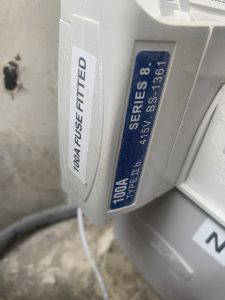
7. How much energy do you use overnight?
When we say overnight we basically mean when the sun isn’t shining and therefore the solar isnt generating – in the UK this varies depending on the time of year. The average home uses about 5-10 kWh per night for things like cooking, dishwashing, kettle, fridges, TV’s computers etc, and a lot more if you are charging your electric car. The amount of energy you use will help us determine what size battery will be best suited for your home. Ideally we would size the battery to cover one full night of usage so that you can charge it up from excess solar energy in the day and run your house off it overnight. That way you get as close to 100% renewable energy use as possible.
8. Do you need to link it with an EV charger?
If you already have an EV and charger then we will need to make sure the EV charger does not drain the battery. The EV will usually have a bigger battery capacity than the home battery and so if you charge your EV from your home battery it will drain quickly. The best solution is to install an EV charger that syncs with your home battery so they work seamlessly together. Each of the brands we mentioned in this BLOG have their own EV charger so you have the option to upgrade your existing EV charger as part of the battery install.
Watch us installing a MyEnergi Zappi EV Charger Here – https://youtu.be/EI6Yt0XwYh4
9. What’s the cable route from the consumer unit to the battery like?
This is when you would be able to help us plan and quote the work that we will be doing for you. It all depends on where your consumer unit is and where you would like your battery to be placed. Pictures will also be useful for us as then we can tell if it will be a more straightforward cable route or a more complicated one.
10. Flexibility schemes.
For you, there are so many different flexibility schemes available that allow you to make even better usage out of your battery system.
One of them is called The National Grid WhenToPlugIn app and this app allows you to see the carbon intensity forecast and lets you know when the electricity in your home will be the cleanest and best to use in the next 48 hours. The app also offers a full breakdown of the energy sources powering the electricity in your region and provides live updates.
Then there is GivEnergy who offer the “GivBack scheme”. This is a new way to earn cash from your battery.
Find out more here – https://givenergy.co.uk/introducing-givback-a-new-way-to-earn-cash-from-your-battery-this-winter/
If you found this information to be useful and you now have decided to get a battery storage system for your home, fill out our quick survey form and we will do our best to provide you with the 5-star service you deserve.
Get a quote here – https://app.openquote.net/company/artisanelectrics
